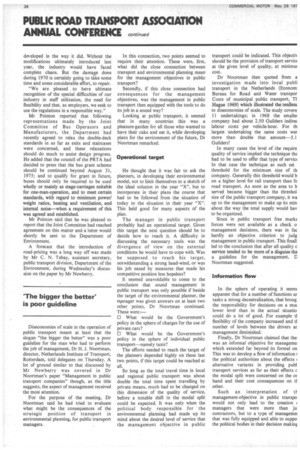'The bigger the better' is poor guideline
Page 46

If you've noticed an error in this article please click here to report it so we can fix it.
Diseconomies of scale in the operation of public transport meant at least that the slogan "the bigger the better" was a poor guideline for the man who had to perform the job of management, Dr H. J. Noortman, director, Netherlands Institute of Transport, Rotterdam, told delegates on Thursday. A lot of ground similar to that discussed by Mr Newberry was covered in Dr Noortman's paper "Management in public transport companies" though, as the title suggests, the aspect of management received the most attention.'
For the purpose of the meeting, Dr Noortman said he had tried to evaluate what might be the consequences of the strategic position of transport in environmental planning, for public transport managers. In this connection, two points seemed to require their attention. These were, first, what did the close connection between transport and environmental planning mean for the management objectives in public transport?
Secondly, if this close connection had consequences for the management objectives, was the management in public transport then equipped with the tools to do its job in a sound way?
• Looking at public transport, it seemed that in many countries this was a pleasure-garden for all those who wanted to have their cake and eat it, while developing plans for the environment of the future, Dr Noortman remarked.
Operational target He thought that it was fair to ask the planners, in developing their environmental model, not to limit themselves to a sketch of the ideal solution in the year "X", but to incorporate in their plans the course that had to be followed from the situation of today to the situation in their year "X". This held good for many aspects of the plan.
The manager in public transport probably had an operational target. Given this target the next question should be to decide how to reach it. A difficulty in discussing the necessary tools was the divergence of view on the external conditions he would have to cope with. Was he supposed to reach his target, notwithstanding a strong head-wind, or was his job eased by measures that made his competitive position less hopeless?
It seemed unavoidable to come to the conclusion that sound management in public transport was only possible if beside the target of the environmental planner, the m,anager was given answers on at least two other points, Dr Noortman continued. These were: 0 What would be the Government's policy in the sphere of charges for the use of private cars?
0 What would be the Government's policy in the sphere of individual public transport—namely taxis?
The efforts needed to reach the target of the planners depended highly on these last two points, if this target could be reached at all.
So long as the total travel time in local and regional public transport was about double the total time spent travelling by private means, much had to be changed on this dimension of the quality of service, before a notable shift in the modal split could be expected. It was only when the political body responsible for the environmental planning had made up its mind about the desired level of service that the management objective in public transport could be indicated. This objectiN should be the provision of transport servic( at the given level of quality, at minimui cost.
Dr Noortman then quoted from a investigation made into local publi transport in the Netherlands (Economi Bureau for Road and Water transpor Costs of municipal public transport, TI Hague 1969) which illustrated thetenClenc to diseconomies of scale. The study covere 11 undertakings; in 1968 the smallei company had about 2.50 Guilders indirec labour costs per vehicle-hour. For th largest undertaking the same costs wer more than double that amount-5.1 Guilders!
In many cases the level of the require quality of service implied the technique ths had to be used to offer that type of servict In that case the technique as such set threshold for the minimum size of th company. Generally this threshold would b on a higher level for rail transport than fo road transport. As soon as the area to b served became bigger than the threshol, size of the public transport company, it wa up to the management to make up its mmn. about the way the total supply would hay to be organized.
Since in public transport free markc forces were not available as a check o. management decisions, there was in fac hardly an objective criterion to judg management in public transport. This final: led to the conclusion that after all quality a service tended to be more of a disguise tha a guideline for the management, D Noortman suggested.
Information flow In the sphere of operating it seem( apparent that for a number of functions ar tasks a strong decentralization, that broug: the responsibility for decisions on a =lc lower level than in the actual situatio could do a lot of good. For example ti flexibility of the company increased and ti number of levels between the drivers ar management diminished.
Finally, Dr Noortman claimed that the] was an informal objective for managemei which extended far beyond its formal on This was to develop a flow of information I the political authorities about the effects alternative Variants in providing publ transport services as far as their effects c the modal split were concerned on the or hand and their cost consequences on ti other.
Such an interpretation of a management-objective in public transpo would not . only lead to the creation < managers that were more than ju contractors, but to a type of managemei that was fully equipped and able to suppo the political bodies in their decision making










































































































